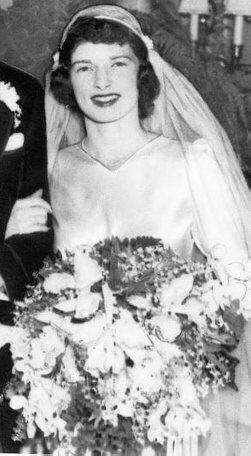Queer
Places:
Old Saint David Church Cemetery
Wayne, Delaware County, Pennsylvania, USA
 Virginia
Tucker Kent Catherwood (April 7, 1915 – April 29, 1966) was a Philadelphia
socialite six years older than
Patricia Highsmith with whom the author had a love affair in 1946. The character of Carol Aird
in the novel "The Price of Salt" and movie Carol (2015) was inspired by her. Catherwood lost custody of her
daughter after her homosexuality was used against her with a taped recording
of a lesbian liaison she had in a hotel room.
Virginia
Tucker Kent Catherwood (April 7, 1915 – April 29, 1966) was a Philadelphia
socialite six years older than
Patricia Highsmith with whom the author had a love affair in 1946. The character of Carol Aird
in the novel "The Price of Salt" and movie Carol (2015) was inspired by her. Catherwood lost custody of her
daughter after her homosexuality was used against her with a taped recording
of a lesbian liaison she had in a hotel room.
Virginia Kent Catherwood was the daughter of Arthur Atwater Kent, Sr., a
wealthy inventor, and Mabel Kent. She attended finishing school and studied sculpture in Paris. Her debutante ball, in December 1933, was said to be the most lavish party
Philadelphia had seen since since the Depression. In 1935 she married wealthy banker Cummins Catherwood and the couple lived on a country estate in Bryn Mawr. Her wedding was extensively covered by the newspapers, and on return from honeymoon the couple lived in a 20-room mansion equipped with garaging for four cars and a swimming pool. Although the couple had a daughter, the romance was short lived, and they divorced in
Idaho on April 4, 1941. It seems Cummins discovered - and was appalled by - his wife’s homosexuality. As
Ann Clark, one of Highsmith’s other lovers, wrote, “Pat only told me the story once, but apparently Virginia lost custody of her child after a recording made in a hotel room and exposing a lesbian affair was played in court. Of course there is something of this tale in The Price of Salt.”
Indeed, as Highsmith wrote the book, she became increasingly anxious there were too many parallels between Virginia and the character Carol Aird. “I worry that Ginnie may feel Carol’s case too similar to her own,” she noted in her diary in 1950.
Highsmith’s relationship with Virginia only lasted for a year, between 1946 and 1947, but the liaison was intense. The rich, glamorous woman gave her a “oneness” and a “timelessness” that allowed her to enter into a fertile state of creativity, she said. She was, Highsmith wrote in her journals, the “other half of the universe”, and “together we make a whole.”
They were together for only a year—Highsmith’s affairs rarely lasted much longer than that—but Catherwood remained an ideal. In her diary, Highsmith rhapsodized, “My green and red goddess, my jade and garnet, my moss and hollyberry, my sea and sun, my marrow and my blood, my stop and go baby, I adore you, I worship you, I kiss you, I cherish you, I defend you, I defy you ever not to love me, I caress your nipples with my tongue.”
However, when the relationship broke down - Virginia was an even heavier drinker than Pat and would sometimes attack her with her fists - Highsmith was left feeling psychologically disturbed. “I am troubled by a sense of being several people,” she wrote. “Should not be at all surprised if I become a dangerous schizophrenic in my middle years.”
Virginia Kent Catherwood made again the news in 1959, when a playboy named
David Mdivani filed a million-dollar lawsuit against her, alleging that she had alienated the affections of his wife,
Virginia Sinclair. One
newspaper ran the headline “woman took his wife from him,” though it can
safely be presumed that few readers understood the full import of this
sentence. The media skirted the matter of homosexuality by stating that
Catherwood had lured Sinclair away by giving her expensive gifts. (Sinclair
was also an heiress.) At one point, a gossip column in the Los Angeles Times
described Sinclair and Catherwood arriving together in the lobby of the
Beverly Hills Hotel after a ski trip to Sun Valley. The reporter, noting that
both women had a “deep ecru” tan, proclaimed, “Very striking—these two
blondes!” Mdivani eventually dropped the lawsuit.
Following sporadic treatment for her alcoholism, Virginia Kent Catherwood
died in 1966 at the age of 51.
My published books:


BACK TO HOME PAGE

 Virginia
Tucker Kent Catherwood (April 7, 1915 – April 29, 1966) was a Philadelphia
socialite six years older than
Patricia Highsmith with whom the author had a love affair in 1946. The character of Carol Aird
in the novel "The Price of Salt" and movie Carol (2015) was inspired by her. Catherwood lost custody of her
daughter after her homosexuality was used against her with a taped recording
of a lesbian liaison she had in a hotel room.
Virginia
Tucker Kent Catherwood (April 7, 1915 – April 29, 1966) was a Philadelphia
socialite six years older than
Patricia Highsmith with whom the author had a love affair in 1946. The character of Carol Aird
in the novel "The Price of Salt" and movie Carol (2015) was inspired by her. Catherwood lost custody of her
daughter after her homosexuality was used against her with a taped recording
of a lesbian liaison she had in a hotel room.
